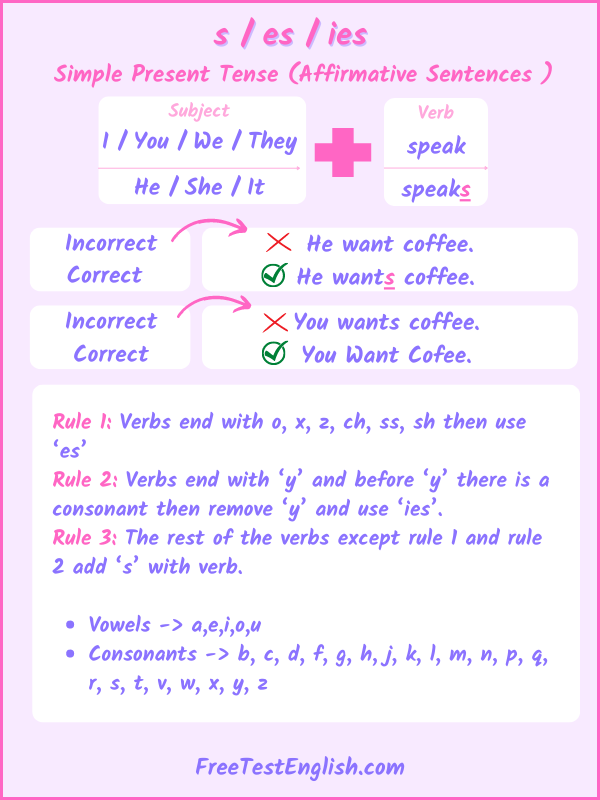Present Simple Tense (s/es/ies)

Present Simple Tense: We use the simple present tense when an action happens regularly (or unceasingly, which is why it’s sometimes called present indefinite). Depending on the person, the simple present tense is formed by using the base form of verb or by adding ‑s/es/ies to the end.
Use of Present Simple Tense:
Rule 1: The action happens all the time, or habitually, in the past, present and future
- For Example: Sadaf teaches her students.
- It is Sadaf’s job to teach her students. She does it every day (in past, present and future).
Rule 2: This situation is now.
- For Example: I want cold drink.
Rule 3: The statement is always true and express general truth.
- For Example: One and one make two.
Rule 4: This is a universal truth that never changes.
- For Example: The sun rises in the east.
When to use s/es/ies with verb
When
Simple Present Tense (Affirmative Sentences) and Subject (Third Person Singular) i.e. He/She/It/Sham/Ramita
Then
Use Verb 1st Form + s/es/ies
i.e.
- He works
- She Works
- We Work
- It Works
Now, where to use s or es or ies.
Rule 5: Verbs end with o, x, z, ch, ss, sh then use ‘es’
For Example
- O -> Go, Do -> Goes, Does
- X -> Fix, Mix -> Fixes, Mixes
- Z -> Buzz -> Buzzes
- CH -> Teach, Reach, Search -> Teaches, Reaches, Searches
- SS -> Wash, Wish, Finish -> Washes, Wishes, Finishes
- SH -> Pass, Cross, Bless -> Passes, Crosses, Blesses
Rule 6: Verbs end with ‘y’ and before ‘y’ there is a consonant then remove ‘y’ and use ‘ies’.
- Vowels -> a,e,i,o,u
- Consonants -> b, c, d, f, g, h, j, k, l, m, n, p, q, r, s, t, v, w, x, y, z
For Example
‘Y’ with a consonant
- Fly – Flies
- Try – Tries
- Cry – Cries
- Worry – Worries
‘Y’ with vowels
- Play – Plays
- Say – Says
- Pay – Pays
Rule 7: The rest of the verbs except rule 1 and rule 2 add ‘s’ with verb.
For example
- Look -> Looks
- Eat -> Eats
- Help ->Helps
- Give -> Gives
- Cut -> Cuts
